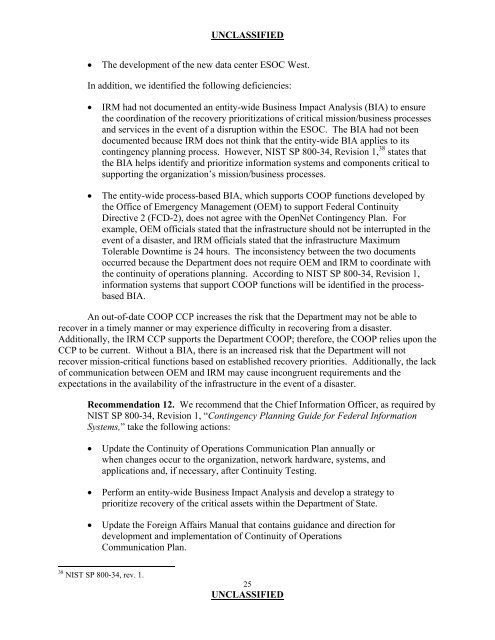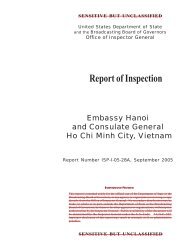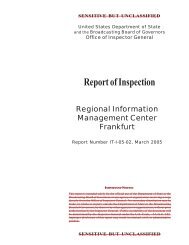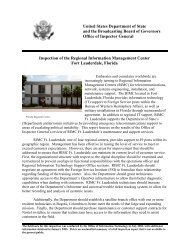Evaluation of Department of State Information Security Program ...
Evaluation of Department of State Information Security Program ...
Evaluation of Department of State Information Security Program ...
Create successful ePaper yourself
Turn your PDF publications into a flip-book with our unique Google optimized e-Paper software.
UNCLASSIFIED<br />
� The development <strong>of</strong> the new data center ESOC West.<br />
In addition, we identified the following deficiencies:<br />
� IRM had not documented an entity-wide Business Impact Analysis (BIA) to ensure<br />
the coordination <strong>of</strong> the recovery prioritizations <strong>of</strong> critical mission/business processes<br />
and services in the event <strong>of</strong> a disruption within the ESOC. The BIA had not been<br />
documented because IRM does not think that the entity-wide BIA applies to its<br />
contingency planning process. However, NIST SP 800-34, Revision 1, 38 states that<br />
the BIA helps identify and prioritize information systems and components critical to<br />
supporting the organization’s mission/business processes.<br />
� The entity-wide process-based BIA, which supports COOP functions developed by<br />
the Office <strong>of</strong> Emergency Management (OEM) to support Federal Continuity<br />
Directive 2 (FCD-2), does not agree with the OpenNet Contingency Plan. For<br />
example, OEM <strong>of</strong>ficials stated that the infrastructure should not be interrupted in the<br />
event <strong>of</strong> a disaster, and IRM <strong>of</strong>ficials stated that the infrastructure Maximum<br />
Tolerable Downtime is 24 hours. The inconsistency between the two documents<br />
occurred because the <strong>Department</strong> does not require OEM and IRM to coordinate with<br />
the continuity <strong>of</strong> operations planning. According to NIST SP 800-34, Revision 1,<br />
information systems that support COOP functions will be identified in the processbased<br />
BIA.<br />
An out-<strong>of</strong>-date COOP CCP increases the risk that the <strong>Department</strong> may not be able to<br />
recover in a timely manner or may experience difficulty in recovering from a disaster.<br />
Additionally, the IRM CCP supports the <strong>Department</strong> COOP; therefore, the COOP relies upon the<br />
CCP to be current. Without a BIA, there is an increased risk that the <strong>Department</strong> will not<br />
recover mission-critical functions based on established recovery priorities. Additionally, the lack<br />
<strong>of</strong> communication between OEM and IRM may cause incongruent requirements and the<br />
expectations in the availability <strong>of</strong> the infrastructure in the event <strong>of</strong> a disaster.<br />
Recommendation 12. We recommend that the Chief <strong>Information</strong> Officer, as required by<br />
NIST SP 800-34, Revision 1, “Contingency Planning Guide for Federal <strong>Information</strong><br />
Systems,” take the following actions:<br />
� Update the Continuity <strong>of</strong> Operations Communication Plan annually or<br />
when changes occur to the organization, network hardware, systems, and<br />
applications and, if necessary, after Continuity Testing.<br />
� Perform an entity-wide Business Impact Analysis and develop a strategy to<br />
prioritize recovery <strong>of</strong> the critical assets within the <strong>Department</strong> <strong>of</strong> <strong>State</strong>.<br />
� Update the Foreign Affairs Manual that contains guidance and direction for<br />
development and implementation <strong>of</strong> Continuity <strong>of</strong> Operations<br />
Communication Plan.<br />
38 NIST SP 800-34, rev. 1.<br />
25<br />
UNCLASSIFIED








